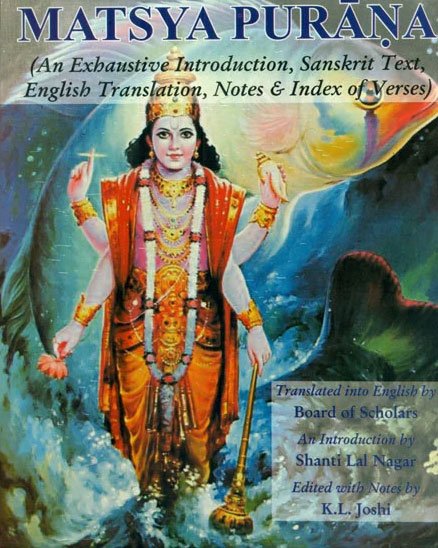The Matsya Purana (critical study)
by Kushal Kalita | 2018 | 74,766 words | ISBN-13: 9788171103058
This page relates ‘Adityashayana-vrata’ of the English study on the Matsya-purana: a Sanskrit text preserving ancient Indian traditions and legends written in over 14,000 metrical verses. In this study, the background and content of the Matsyapurana is outlined against the cultural history of ancient India in terms of religion, politics, geography and architectural aspects. It shows how the encyclopedic character causes the text to deal with almost all the aspects of human civilization.
Part 4.2g - Ādityaśayana-vrata
This is also known as Ādityaśayanaśankarārcana observance.[1] This auspicious vrata falls on the Sunday when there is saṃkrānti and also on the seventh day of dark fortnight when the moon is in the Hasta nakṣatra.[2] In this vrata Śiva is shown as non different from Āditya and consequently the devotee uttering the mantras addressing Āditya worships Śiva.[3] The 55th chapter of the Matsyapurāṇa discusses the Ādityaśayanavrata elaborately. This vrata is observed by both man and woman. By observing this vrata the devotee attains divine facility and remains free from all diseases, grieves, and sufferings.[4]
The Matsyapurāṇa describes the procedure of observing this vrata thus:
One who wants to observe this vrata should worship Maheśvara and Umā. Reciting the names of Āditya he also worships the Sun on a liṅga of Śiva. Lord Śiva is non-different from Sūrya and hence Śiva is worshipped with the mantra:
“sūryāya namaḥ”.
The mantras are also chanted for different limbs honouring different Nakṣatras starting with Hastā, Citrā etc. The devotee, during this vrata, does not take oil, flesh, green vegetables, and take food only at night. On the Punarvasu nakṣatra the devotee offers rice along with clarified butter to the brāhmaṇa in a vessel made of fig-leaves putting there some gold. On the 7th year of the fast the devotee gives gifts of a pair of clothes to the brāhmaṇa. On completion of the 14th year the brāhmaṇa is offered molasses, milk, and clarified butter. And after that the devotee gives golden lotus along with gems, bedsheets, pillow, shoes, utensils, cāmara etc. to the needy brāhmaṇa. A cow is also given to the brāhmaṇa on that occasion. [5] And then the Sun is prayed for getting lustre, fortune, and prosperity.[6]
This vrata is also found treated in the same way in the Padmapurāṇa.[7] No reference of the prevalence of this vrata in the present day society is found by us. It is not known whether this vrata is observed in any part of India.
Footnotes and references:
[2]:
yadā hastena saptamyāmādityasya dinaṃ bhavet/ suryyārcyāṃ cātha samkrāntistithiḥ sā sārvakāmikī// Ibid., 55.4
[3]:
umāpateravervāpi na bhedo dṛsyate kvacit/ yasmāttasmānmuniśreṣṭha gṛhe śambhuṃ samarcayet // Ibid., 55.6
[4]:
Ibid., 55.31
[5]:
Ibid., 55.7-25
[6]:
[7]:
Padmapurāṇa, V.24.64-96
